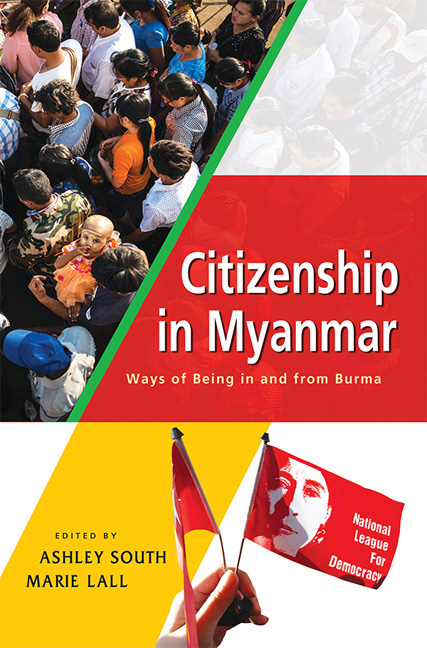Book contents
- Frontmatter
- Dedication
- Contents
- Foreword
- The Contributors
- Map of Myanmar
- Introduction
- 1 Ethnic Politics and Citizenship in History
- 2 Representation and Citizenship in the Future Integration of Ethnic Armed Actors in Myanmar/Burma
- Special Contribution: The Way Forward for Peace, Stability and Progress in Burma/Myanmar
- 3 National Political Dialogue and Practices of Citizenship in Myanmar
- 4 Citizenship and Minority Rights: The Role of “National Race Affairs” Ministers in Myanmar's 2008 Constitution
- Special Contribution: Karenni People at a Glance
- 5 Myanmar's Youth and the Question of Citizenship
- Special Contribution: I Am a Citizen of Myanmar
- 6 “The Value of Life”: Citizenship, Entitlement and Moral Legibility in Provincial Myanmar
- Special Contribution: How I Became Shan
- 7 Conflict and Mass Violence in Arakan (Rakine State): The 1942 Events and Political Identity Formation
- 8 Exploring the Issue of Citizenship in Rakhine State
- Special Contribution: Rohingya and Nationality Status in Myanmar
- 9 Myanmar's Other Muslims: The Case of the Kaman
- Special Contribution: Interview with P'doh Kweh Htoo Win
- Index
Special Contribution: Karenni People at a Glance
Published online by Cambridge University Press: 28 June 2018
- Frontmatter
- Dedication
- Contents
- Foreword
- The Contributors
- Map of Myanmar
- Introduction
- 1 Ethnic Politics and Citizenship in History
- 2 Representation and Citizenship in the Future Integration of Ethnic Armed Actors in Myanmar/Burma
- Special Contribution: The Way Forward for Peace, Stability and Progress in Burma/Myanmar
- 3 National Political Dialogue and Practices of Citizenship in Myanmar
- 4 Citizenship and Minority Rights: The Role of “National Race Affairs” Ministers in Myanmar's 2008 Constitution
- Special Contribution: Karenni People at a Glance
- 5 Myanmar's Youth and the Question of Citizenship
- Special Contribution: I Am a Citizen of Myanmar
- 6 “The Value of Life”: Citizenship, Entitlement and Moral Legibility in Provincial Myanmar
- Special Contribution: How I Became Shan
- 7 Conflict and Mass Violence in Arakan (Rakine State): The 1942 Events and Political Identity Formation
- 8 Exploring the Issue of Citizenship in Rakhine State
- Special Contribution: Rohingya and Nationality Status in Myanmar
- 9 Myanmar's Other Muslims: The Case of the Kaman
- Special Contribution: Interview with P'doh Kweh Htoo Win
- Index
Summary
National identity can be complex in Myanmar due in part to the large number of ethnic groups in the country. Estimates vary, although official sources at various times have listed over 100 diverse groups having distinctive beliefs, customs and language. Members of ethnic groups generally have a strong affiliation to their group, especially so given the history of conflict between a number of major ethnic groups and the central government in modern Myanmar. As the restoration of democracy and the resolution of conflicts proceeds, Myanmar “citizenship” may best be viewed as a layered personal experience, involving both an ethnic and national identity. Some of the larger groups to that are well known are the Chin, Kachin, Shan, Mon, Karen — and the one of concern here, the Karenni.
ORIGINS OF THE KARENNI PEOPLE AND STATE
The Karenni people (also known at times as “Red Karen”) are believed to have descended from the Mongolian plateau at a time of food scarcity in the Gobi Desert, and as a result of oppression from other ethnic groups living in Mongolia. The Karenni gradually moved downward along the Yellow River and briefly settled in what today is the Chinese state of Yunnan. They continued moving down along Salween River and finally settled in Dee Maw Soe in 739 BCE (although some historians claim it was not until the early 800s CE). Where the Karenni live today is known as Kayah — formerly called Red Karen or Karenni.
Not long after having established their own Karenni nation, Yeun troops from the north attacked a number of times, finally overcoming them and establishing control of the area for almost a hundred years. During this time of being ruled by the Yeun king, Karenni people were treated as slaves, forced to work their own paddy fields for the benefit of the Yeun king, and taxed unfairly.
Finally, the Karenni people could no longer tolerate the Yeun king's oppression and taxation, and revolted. They collected all available arms, and began a war to expel the Yeun troops. One story from this time concerns the importance of “sticky rice”. The Karenni females who were left behind cooked and packed rice with leaves to be sent to the frontline as the main ration for troops in the battlefield. But the packed-rice did not last long in the hot climate, often rotting in one day, which slowed attempts to advance.
- Type
- Chapter
- Information
- Citizenship in MyanmarWays of Being in and from Burma, pp. 140 - 144Publisher: ISEAS–Yusof Ishak InstitutePrint publication year: 2017



